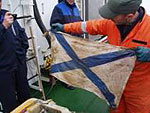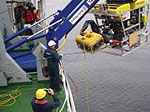NATO ship used in survey of sunken Russian submarine wreck

Photos courtesy of the UK MOD
The NATO research vessel "Alliance" was recently engaged in surveying the wreck of a sunken Russian nuclear submarine, at the request of the Russian Federation and as part of an international effort.
The UK Ministry of Defence, which led the international effort, requested the use of the "Alliance" from 21 June to 7 July, due to the unique capabilities of the ship to perform oceanographic research and surveying. The "Alliance" -- which is managed by a NATO research centre in Italy -- was used, in this operation, as the host ship for the NATO Submarine Rescue System Intervention Remotely Operated Vehicle that is owned jointly by the United Kingdom, France and Norway.

Photos courtesy of the UK MOD
The decommissioned Russian submarine, B-159, was being towed to a breakers yard in 2003, when it broke loose and sank in rough weather in the Barents Sea at the entrance of the Murmansk River, resulting in the loss of nine Russian sailors. Two nuclear reactors were onboard the submarine when it sank, but the reactors were shut down and in a safe state. This survey was the first stage of an international recovery effort.
Upon arrival at the wreck site under the escort of a Russian naval vessel, the survey team was officially welcomed by Vice Admiral Maksimov, Deputy Commander in Chief of the Northern Fleet. The location and position of the submarine was quickly found using sensors on the "Alliance" and debris was removed from the vicinity of the wreck. Radiation monitoring indicated no radiation hazard from the submarine.
A highlight of the operation was the recovery of a small Russian Remotely Operated Vehicle that had become entangled in the wreck a few years ago, as well as the Russian Federation naval flag that had been flying on the B-159 when she sank. These were returned to Admiral Maksimov, once returned to the surface.

